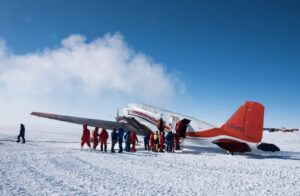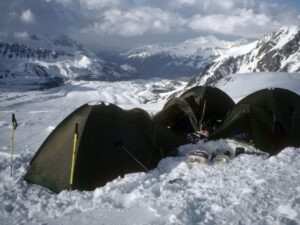Leo Houlding’s team has completed its expedition to Mount Roraima, a flat-topped mountain straddling the border of Guyana, Brazil and Venezuela.
Houlding, Anna Taylor, Wilson Cutbirth and Waldo Etherington airdropped almost a ton of gear into the Guyana jungle on November 9. With 17 local guides and porters, they then hiked through the jungle for over a week to the base of Mount Roraima.

Mount Roraima’s imposing prow. In the foreground, members of the team haul gear. Photo: Leo Houlding/Berghaus
By November, 18 they had set up a base camp, then arduously rigged 300m of wet rock and slime-covered trees to reach an advanced camp at the very base of the prow. Unfortunately, it soon became apparent that the rain pouring off the mountain made this a poor staging post. Instead, they rigged a spectacular-looking portaledge camp and used the wall’s overhang to shield them from the elements.

The portaledge camp. Photo: Leo Houlding
Between breaks in the rain, they considered their options. Eventually, they elected to tackle the prow straight on, following the original 1973 British route. Switching to “big wall mode”, they made good progress. The sheer rock face and overhangs helped keep them remarkably dry, though loose rock made progress fiddly.
Houlding led the first three pitches and treated them like “a vertical gardening and rockery project.” While Houlding and Cutbirth pushed the rope higher, Taylor worked on free climbing the lower pitches.
Houlding and Cutbirth traversed left after pitch four, away from the 1973 route. At first, they found the wall well-featured, but as they progressed, the ledges became thin and flaky. Houlding had to use their drill and place a bolt to continue up to an “invisible ledge”, which was actually just invisible from the ground. In fact, it was almost a metre thick and nearly 10m wide, a perfect spot for another camp from which to stage the remainder of the climb.

Houlding on pitch five. Photo: Berghaus / Leo Houlding
Their upper line wound under overhangs and over precarious hanging slabs. Houlding and Cutbirth took turns as lead, onsighting most pitches. Houlding fell on a steep, loose pitch less than a metre from a belay, which ended his effort to free the entire route. Soon after, on December 2, Houlding, Cutbirth and Etherington topped out.
They spent the next few days moving equipment to the summit before Houlding was able to return to the one pitch that he had failed to free climb. He inspected the route from the top rope and was able to complete it quickly on his second go.
The rest of the team, including two local guides who had only learned rope techniques during this expedition, topped out and celebrated in thick mist. On December 5, they were picked up from the summit by helicopter.

A quick summit photo. Photo: Leo Houlding/Berghaus






